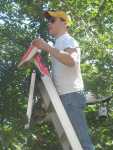Steps toward healing

By Lynn A. Wade
Nevada Daily Mail
The children represented by dozens of pairs of shoes hanging from a tree on the courthouse lawn have walked in territory no child should ever have to cross.
The shoes represent the 284 reports of child abuse in Vernon County in 2006 alone.
From January to September, the Children's Center has served 119 children age 6 and younger; 105 children ages 7-12; and 74 children ages 13-17.
The number of reports are increasing, in part because of the increasing availability of services in the area, said Amy Koopman of the Children's Center, a local facility that serves as an interview and medical evaluation center for children suspected to be the victims of child abuse. The center also serves as a funnel for information about child abuse education and prevention in the area.
"You can never do too much to make people more aware," that child abuse is a problem in the community, said a volunteer, tying a pair of shoes together for hanging on the tree on Saturday morning.
"The more agencies that know about us, the more (cases) we hear about," Koopman added.
It's a dark, almost hidden reality that there's a need for the center.
"It's there. It could be your neighbor, someone you see at the grocery store. It's not always who you think will abuse," said Jennifer Thomas of the Vernon County juvenile office told the Daily Mail in 2005.
Myths about child abuse abound. For example, many believe child sexual abuse occurs only among strangers, but national statistics say that in about 85 percent of cases, the victim knows the offender.
Some also believe that victims provoke sexual abuse through provocative behavior; but the responsibility for the act lies with the offender.
Many people believe that the majority of victims tell someone about the crime, but statistics show that nearly two-thirds of victims don't tell anyone because they fear being blamed, punished or not believed.
Other common myths are that the child could simply tell the offender to stop, that all victims of sexual abuse are girls; but experts say that children generally do not question adults and have been taught to obey adults.
Victims are often coerced by bribes or threats, and victims may be male or female, according to the center.
